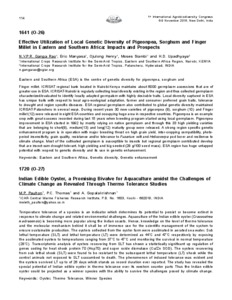Effective Utilization of Local Genetic Diversity of Pigeonpea, Sorghum and Finger Millet in Eastern and Southern Africa: Impacts and Prospects
Abstract
Eastern and Southern Africa (ESA) is the centre of genetic diversity for pigeonpea, sorghum and Finger millet. ICRISAT regional bank located in Nairobi-Kenya maintains about 6000 germplasm accessions that are of greater use in ESA. ICRISAT-Nairobi is regularly collecting local diversity existing in the region and thus collected germplasm characterized/evaluated to identify locally adapted germpalsm with highly desirable traits. Local diversity captured in ESA has unique traits with respect to local agro-ecological adaptation, farmer and consumer preferred grain traits, tolerance to drought and region specific diseases. ESA regional germplasm also contributed to global genetic diversity maintained ICRISAT-Patancheru in several ways. During recent years 30 new varieties of pigeonpea (8), sorghum (10) and Finger millet (12) were released in eight ESA countries and occupying huge area in respective countries. Pigeonpea is an example crop with great success recorded during last 15 years when breeding program started using local germplasm. Pigeonpea improvement in ESA started in 1992 by mostly relying on native germplasm and through this 33 high yielding varieties that are belonging to short(8), medium(13) and long(12) maturity group were released. A strong region specific genetic enhancement program is in operation with major breeding thrust on high grain yield, inter-cropping compatibility, photoperiod insensitivity, grain quality, resistance and/or tolerance to Fusarium wilt and Helicoverpa pod borer and resilience to climate change. Most of the cultivated germplasm is susceptible to insects but regional germplasm contributed develop that are insect-cum-drought tolerant, high yielding and big seeded (28 g/100 seed mass). ESA region has huge untapped potential with respect to genetic diversity and its use in genetic enhancement

